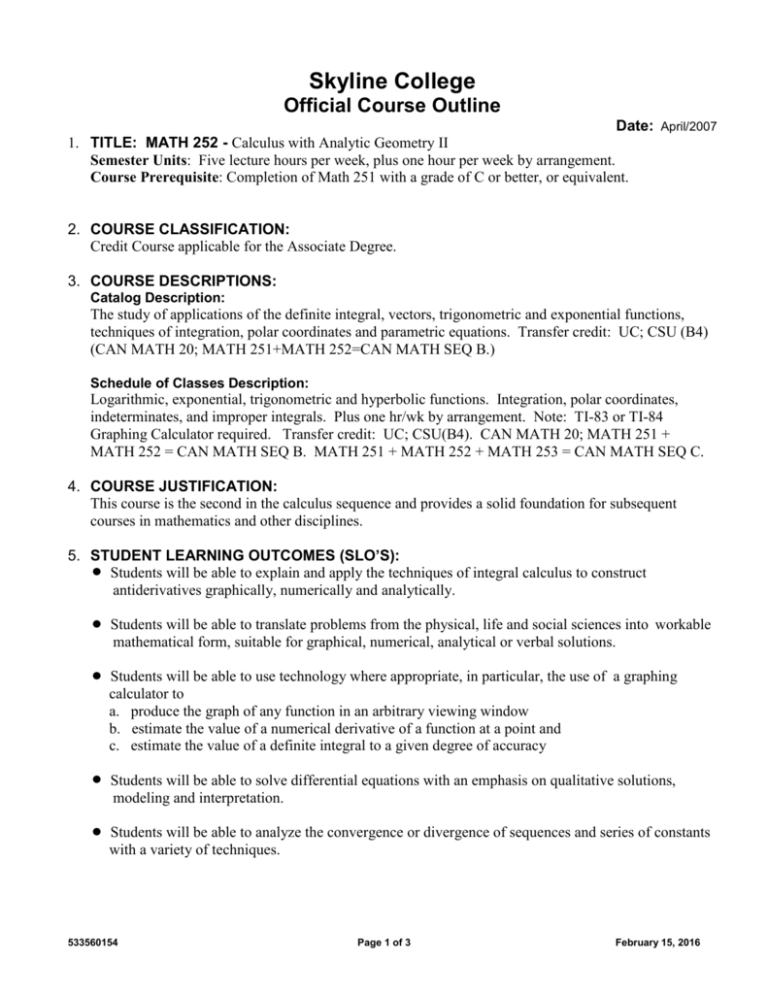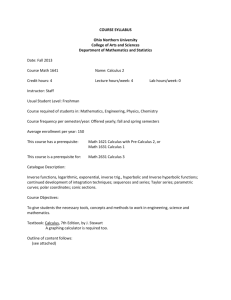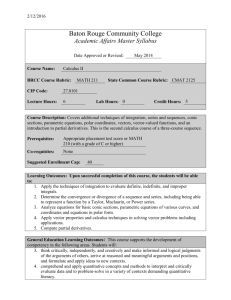Course Outline Form
advertisement

Skyline College Official Course Outline Date: April/2007 1. TITLE: MATH 252 - Calculus with Analytic Geometry II Semester Units: Five lecture hours per week, plus one hour per week by arrangement. Course Prerequisite: Completion of Math 251 with a grade of C or better, or equivalent. 2. COURSE CLASSIFICATION: Credit Course applicable for the Associate Degree. 3. COURSE DESCRIPTIONS: Catalog Description: The study of applications of the definite integral, vectors, trigonometric and exponential functions, techniques of integration, polar coordinates and parametric equations. Transfer credit: UC; CSU (B4) (CAN MATH 20; MATH 251+MATH 252=CAN MATH SEQ B.) Schedule of Classes Description: Logarithmic, exponential, trigonometric and hyperbolic functions. Integration, polar coordinates, indeterminates, and improper integrals. Plus one hr/wk by arrangement. Note: TI-83 or TI-84 Graphing Calculator required. Transfer credit: UC; CSU(B4). CAN MATH 20; MATH 251 + MATH 252 = CAN MATH SEQ B. MATH 251 + MATH 252 + MATH 253 = CAN MATH SEQ C. 4. COURSE JUSTIFICATION: This course is the second in the calculus sequence and provides a solid foundation for subsequent courses in mathematics and other disciplines. 5. STUDENT LEARNING OUTCOMES (SLO’S): Students will be able to explain and apply the techniques of integral calculus to construct antiderivatives graphically, numerically and analytically. Students will be able to translate problems from the physical, life and social sciences into workable mathematical form, suitable for graphical, numerical, analytical or verbal solutions. Students will be able to use technology where appropriate, in particular, the use of a graphing calculator to a. produce the graph of any function in an arbitrary viewing window b. estimate the value of a numerical derivative of a function at a point and c. estimate the value of a definite integral to a given degree of accuracy Students will be able to solve differential equations with an emphasis on qualitative solutions, modeling and interpretation. Students will be able to analyze the convergence or divergence of sequences and series of constants with a variety of techniques. 533560154 Page 1 of 3 February 15, 2016 6. SPECIFIC INSTRUCTIONAL OBJECTIVES: Specific objectives include: Explain the techniques of the calculus and provide practice in their applications. Develop the ability to translate practical problems into workable mathematical form, using material from the fields of physical science, engineering, and other disciplines presenting the logical structure of the subject. Develop an understanding of the principles of mathematical analysis and increase abilities in logical reasoning. 7. COURSE CONTENT: Applications of the definite integral a. Areas between two curves b. Volumes of solids of revolution c. Area of surface of revolution d. Length of plane curves e. Work f. Liquid pressure and force g. Centroids 533560154 The calculus of inverse functions a. Inverse functions b. Inverse trigonometric functions c. The natural exponential function d. General exponential functions e. Additional indeterminate forms f. Exponential growth and decay g. Separable differential equations h. Hyperbolic functions i. Inverse hyperbolic functions Techniques of Integration a. Integration by Parts b. Integration powers of sine and cosine c. Integration powers of secant and tangent d. Trigonometric substitution e. Integrals involving quadratic forms f. Integrating rational functions g. Miscellaneous substitutions h. Numerical integration, Simpson’s Rule Polar coordinates and parametric equations a. Polar coordinates b. Graphs in polar coordinates c. Area in polar coordinates d. Parametric equations e. Tangent lines and arc length in polar equations Page 2 of 3 February 15, 2016 Sequences and Series a. Geometric Series b. Convergence of series c. Test for convergence of series d. Power Series and Interval of Convergence e. Taylor Polynomials and Series f. Finding and applying Taylor Series g. Fourier Series Differential Equations a. Slope Fields b. Euler’s Method c. Separation of Variables d. Applications and Modeling of differential equations e. Systems of differential equations f. Second Order differential equations g. Linear second-order differential equations 8. REPRESENTATIVE METHODS OF INSTRUCTION: Course will be taught with a lecture/discussion format. 9. ASSIGNMENTS: Students will be given out of class textbook reading assignments and problem sets to solve. An important aspect of this class is for students to be able to apply mathematical techniques to a variety of symbolic and written problems. They must be able to analyze problems and determine appropriate methods for calculating results or solving equations. 10. EVALUATION OF STUDENT PERFORMANCE: Students will be evaluated on the basis of regular examinations and a comprehensive final examination. (At the option of the instructor, homework and quizzes may also be part of the evaluation.) Letter graded. Students will be evaluated on their ability to analyze problems, determine appropriate methods, set up diagrams, execute calculations, and correctly interpret numerical answers. Work of this type will be done during class time and as part of outside classroom assignments. Critical thinking skills are necessary to correctly analyze problems, model problems, draw appropriate diagrams and graphs, and correctly interpret results. 11. RECOMMENDED or REQUIRED TEXT(S): Example of an acceptable text: Calculus, Single and Multivariable, 4th Edition, Hughes-Hallett, et al.; Wiley, 2005 533560154 Page 3 of 3 February 15, 2016








